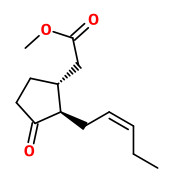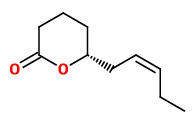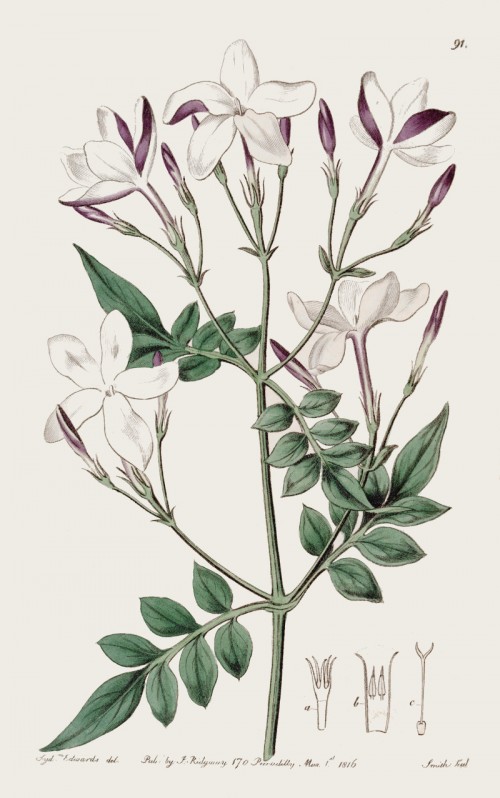Dies ist eine alte Version des Dokuments!
Jasminum grandiflorum L. - Oleaceae - Catalonian jasmine, Spanish jasmine, Royal jasmine, Chinesischer Tee-Jasmin
Twining deciduous shrub , up to 4m high, native from Northeast Africa to India, occasionally naturalized in tropics, cultivated widely as ornamental.
Subspecies:
Jasminum grandiflorum subsp. floribundum = Jasminum floribundum R. Br. ex Fresen.: native to Africa, Arabia
Jasminum grandiflorum subsp. grandiflorum: South Asia, cultivars and naturalized populations
http://en.wikipedia.org/wiki/Jasminum_grandiflorum
„By method of solvent extraction the Jasmine flowers are converted into Jasmine Concrete and Jasmine Oleoresin (sold as Jasmine Absolute). Both products have a huge demand in the fragrance industry.“ https://en.wikipedia.org/wiki/Jasminum_grandiflorum
Extraction of Turkish jasmine flowers with n-hexane and evaporating of the solvent yielded jasmine concrete (0.20-0.28%). Treating with twenty-fold the weight of alcohol and evaporation of the solvent gave jasmine absolute (39-56%). French, Italian, Indian, Moroccan, Egyptian and Turkish absolutes contained alcohol (2.9-36.3%), linalool (2.5-4.3%), benzyl acetate (9.0-18.8%), benzyl alcohol (0.6-2.0%), nerol/geraniol (0-0.5%), nerolidol (0-1.4%), p-cresol (0.08-1.3%), eugenol (0.1-1.5%), methyl anthranilate/methyl palmitate (0.8-1.7%), jasmonates (0.3-1.0%), isophytol/farnesol (7.5-13.9%), indole (0.4-4.0%), methyl linoleate/vanillin (0.5-2.3%), and benzyl benzoate (1.0-3.5%).
[Anac, Olcay. „Gas chromatographic analysis of absolutes and volatile oil isolated from Turkish and foreign jasmine concretes.“ Flavour and fragrance journal 1.3 (1986): 115-119]
The comparative headspace analysis of living vs. picked J.grandiflorum flowers showed interesting varaiation of constituents (living/picked): 6-methyl-5-hepten-2-one (0.2/0%), (Z)-3-hexenyl acetate (0.2/0%), (Z,E)-ocimene (0.2/1.1%), benzyl alcohol (0/4%), benzyl acetate (60/40%), linalool (3/30%), indole (11/2%), cis-jasmone (3/0%), 3,5-dimethyl 2-ethylpyrazine (0/0.5%), methyl jasmonate (0.3/0%).
[The chemistry of flowers, fruits and spices: live vs. dead-a new dimension in fragrance research., Mookherjee, B.D., Trenkle, R.W., Wilson, R.A., Pure and Applied Chemistry, Vol.62(7), 1990, 1357-1364] http://media.iupac.org/publications/pac/1990/pdf/6207x1357.pdf
 cis-jasmone |  methyl trans-(Z)-jasmonate ((-)-methyl jasmonate) |  (+)-epi-methyl jasmonate |  (-)-δ-jasmolactone |
The headspace of J.grandiflorum cultivated in Grasse contained maltol, which contributes an attractive and characteristic 'jammy' note to the flower scent.
[Joulain, Daniel. „Flower scents from the Pacific.“ Chemistry & biodiversity 5.6 (2008): 896-909]
J.grandiflorum flowers yield 0.2% concrete and from that, 0.1% absolute (8 million flowers = 1000kg give 2.3kg concrete and 1kg absolute). Main components are benzyl acetate (34%), benzyl benzoate (24%), benzyl alcohol (5%), linalool (8%), cis-jasmone (3%), and 1H-indole (2.5%), which together total more than 75% (as shown by works from Albert Hesse and Friedrich Müller 1899-1904). Additional 94 trace compounds that contribute to the typical odor of jasmine absolute have been identified, like p-cresol, geraniol, (E,E)-farnesol, (+)-(R,E)-nerolidol, α-terpineol, and vanillin. The methyl jasmonates (-)-methyl jasmonate (1.7%) and (+)-epi-methyl jasmonate (0.2%; 400 times more potent then the former) comprise the odorous principle of jasmine. δ-Jasmolactone (6-[(Z)-pent-2-enyl]oxan-2-one, 1.5%) contributes with pleasant sweet floral fruity notes to the character of jasmine absolute.
[Scent and Chemistry, Günther Ohloff, Wilhelm Pickenhagen, Philip Kraft, Wiley-VCH, 2012, 259-266]
Benzene extracts of Egyptian jasmine flowers and supercritical fluid extracts of ethanolic infusions
of French Jasminum grandiflorum flowers showed maltol also to be a key odorant. Conventional hexane extraction produces absolutes which contain comparatively much lower amounts of maltol (which is significantly soluble in benzene and ethanol, but only poorly solubilized in hexane). Maltol could also be detected in the headspace of living jasmine flowers, contributing to the exquisite fragrance of natural jasmine.
[Nicolas Baldovini, Jean-Jacques Filippi, „Natural Fragrant Raw Materials“ in: Buettner, Andrea, ed. Springer Handbook of Odor. Springer, 2017, 45; lit. cit.]

Jasminum grandiflorum L., Malati, Botanical Register, vol. 2: t. 91 (1816) [S. Edwards]
http://www.plantillustrations.org/illustration.php?id_illustration=96958
